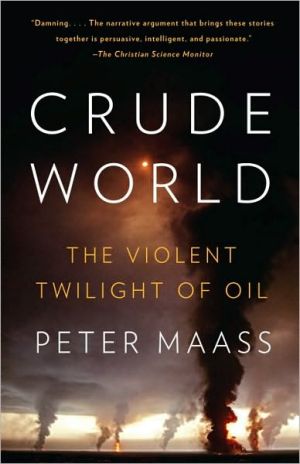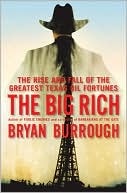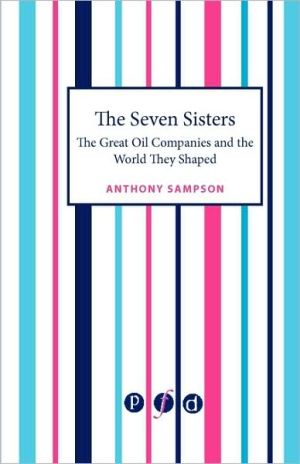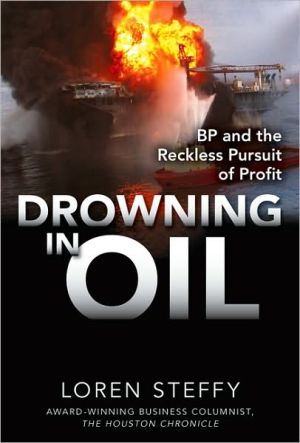Crude World: The Violent Twilight of Oil
The Catastrophic Oil Spill in the Gulf of Mexico has brought new attention to the huge costs of our oil dependence. In this stunning and revealing book, Peter Maass examines the social, political, and environmental impact of petroleum on the countries that produce it.\ Every unhappy oil-producing nation is unhappy in its own way, but all are touched by the "resource curse"-the power of oil to exacerbate existing problems and create new ones. Maass presents a vivid portrait of the troubled...
Search in google:
A stunning and revealing examination of oil's indelible impact on the countries that produce it and the people who possess it.Every unhappy oil-producing nation is unhappy in its own way, but all are touched by the "resource curse"-the power of oil to exacerbate existing problems and create new ones. In Crude World, Peter Maass presents a vivid portrait of the troubled world oil has created. He takes us to Saudi Arabia, where officials deflect inquiries about the amount of petroleum remaining in the country's largest reservoir; to Equatorial Guinea, where two tennis courts grace an oil-rich dictator's estate but bandages and aspirin are a hospital's only supplies; and to Venezuela, where Hugo Chávez's campaign to redistribute oil wealth creates new economic and political crises.Maass, a New York Times Magazine writer, also introduces us to Iraqi oilmen trying to rebuild their industry after the... The Barnes & Noble Review The price of gas is more familiar than the price of crude oil, but consider this: In the past decade, the price of a barrel went from $12 in 1999 to $147 in 2008, settling in at about $70 today. The present equilibrium will not last, projects Peter Maass, for we face "an era of scarcity that involves higher prices for oil and fiercer competition for what's left." Among the many baleful books on peak oil, Crude World stands out for its reportage on what was once called "underdevelopment," or plunder. In one excruciating example after another, Maass -- a New York Times Magazine writer -- shows how energy companies impoverish the countries from which they extract oil. Few reporters have bothered to visit Equatorial Guinea, but Maass does, finding that ExxonMobil, Halliburton, ChevronTexaco, Marathon, and Total have enriched the country's tiny elite, with dictator Teodoro Obiang siphoning $700 million into his private accounts. Employment has not improved, for the rig workers are imported Indians and Filipinos. Equatorial Guinea is mired in destitution, malnourishment, and disease, even though the oil payments, if distributed, would bring $25,000 a year to every citizen. In Nigeria, oil was discovered by geologists working for Shell. There, writes Maass, "nine out of ten citizens live on less than $2 a day and one out of five children dies before his fifth birthday" since "80 percent of Nigeria's oil wealth has gone to 1 percent of the population." If we are inured to stories of petrodollar terrorism, global overheating, and the precariousness of a world economy built on oil, the originality of Crude World is to follow the hose backward, from pump to refinery to well, showing us why every time we fill up the tank we are haunted by the spectral wraiths of Nigeria and Equatorial Guinea -- or ought to be. --Christopher Phelps
Chapter 1\ Scarcity\ For a man warning of a coming apocalypse, Matthew Simmons was surprisingly cheerful.\ Simmons is the prosperous founder of a niche investment firm that specializes in mergers and acquisitions in the energy sector. A graduate of Harvard Business School, a member of the Council on Foreign Relations, a frequent flier on corporate jets, an adviser to George W. Bush during his first presidential campaign, and a best- selling author, Simmons would be a card-carrying multimillionaire member of the global oil nomenklatura, if cards were issued for such things. But his wonderful life has a cloud, which consists of his belief that the American dream and the world as we know it are on the verge of falling apart.\ "If it turns out I am wrong, I will be the happiest guy in the world," Simmons told me. Despite his dire prediction, he retained a mischievous demeanor. We met during a trip he made to Manhattan to talk to a group of oil-shipping executives. The impression he gave was of an enthusiastic inventor sharing a discovery (the coming apocalypse) that had taken him by surprise. He had a wide-eyed wonder in his regard, as if a bit of mystery could be found in everything that caught his eye. Whether he was saying the sky was blue or that it was falling, he emitted a happy wink.\ His journey into the apocalypse began innocently enough. In 2003, Simmons visited Saudi Arabia on a government-sponsored tour for business executives. The group was presented with the usual dog and pony show, but instead of being impressed with the size and expertise of the kingdom's oil industry, Simmons became perplexed. A senior manager at Saudi Aramco, the state-owned oil company, told the visitors that "fuzzy logic" was used to estimate the oil that could be recovered from the country's reservoirs. Simmons wondered what could be fuzzy about the contents of an oil reservoir. He realized that Aramco, despite its assurances of bottomless supplies, might not know how much oil remained.\ He returned home with an intellectual itch. Saudi Arabia was one of the charter members of OPEC, an organization founded in 1960 to coordinate the policies of the major oil producers. Like every OPEC member, Saudi Arabia provides only general numbers about its output and reserves. It does not release details of how much oil is extracted from each reservoir or what methods are used to extract that oil or how much water emerges with the oil, and it does not permit outside audits or inspections. The condition of Saudi fields-like the condition of almost all OPEC fields-is a closely guarded secret. That's partly because the cartel's production quotas, which keep oil off the market to avoid gluts that drive down prices, are based on each country's reserves. The larger an OPEC member's reserves, the higher its quota. Most, if not all, OPEC members have exaggerated the size of their reserves to have the largest possible quota and thus the largest possible revenues.\ During the decades of low prices and overabundant supplies, oilmen like Simmons did not care about OPEC's fudged numbers. Whether or not OPEC reserves were hyped, whether or not the cartel's fields were nearing a midlife crisis, plenty of crude was coming out of the ground. Only a boycott or a war could squeeze supplies, it seemed, and only for a short time. But while visiting Saudi Arabia in 2003, when the price of a barrel was around $30 and rising, thanks in part to China's emergence as a voracious importer, Simmons asked himself whether something might be amiss. Perhaps the world didn't have as much oil as was thought.\ As a teenager, Simmons had been on a high school debate team that reached the state championships, and from that experience he'd learned the importance of possessing information, of knowing his subject. He has never been a fan of fuzzy logic or fuzzy anything; he likes hard data. He wanted to know, to truly know, what was happening in Saudi fields-how many wells were drilled into them, how much oil each well produced, which recovery methods were used and the trend line of output since the wells had been opened.\ It was a mystery crafted for his curious mind. After returning home and immersing himself in the minutiae of oil geology, Simmons realized that uncollated data might be found in the neglected research of the Society of Petroleum Engineers. Oil engineers, like most professionals, have regular conferences at which they present obscure papers that delve into the work they do. Technical and detailed, the papers are debated at the conferences, published by the SPE in a little-read journal, and then forgotten.\ Simmons realized that the answers were hiding in plain sight. He found more than two hundred papers that no one had pulled together into a meta-analysis. Though they covered only portions of the kingdom's wells and some of them were several decades old, they contained useful data about the condition of the fields. Two months before we met in New York City, Simmons had shocked the oil world by publishing a book, Twilight in the Desert, in which he said:\ The geological phenomena and natural driving forces that created the Saudi oil miracle are conspiring now in normal and predictable ways to bring it to its conclusion, in a time frame potentially far shorter than officialdom would have us believe.?.?.?.?Saudi Arabia clearly seems to be nearing or at its peak output and cannot materially grow its oil production.\ The denunciations arrived by the supertanker. Saudi officials described Simmons as deluded. Daniel Yergin, the closest thing the oil world has to a guru, treated Simmons as a naïve, overcaffeinated student jumping out of his seat to insist that the professor is wrong; the professor patted the student on the shoulder and kindly asked him to sit back down.\ Between Simmons's trip to Saudi Arabia and the publication of his book two years later, in 2005, the price of oil had nearly doubled. When we met at that time, Simmons had a look of mischief on his face, even though he was saying the world might be heading toward disaster.\ At times of economic expansion, why does oil cost so much? Before the onset of the global economic crisis in the fall of 2008, a barrel fetched $147. The price is expected to return to triple digits when the recession ends. Just how high will it go? That leads to the essential question of how much oil is left in the world.\ If you listen to Ali al-Naimi, the Saudi oil minister, you will hear about infrastructure. He tells audiences there are not enough wells, pipelines, or refineries to extract and distribute the quantities of oil the United States, China and the European Union require in boom times. He says that when there's a price spike, we should cut back on driving or buy a smaller car and wait a few years, and soon the world will again have enough petroleum. Yergin likes to emphasize political problems-if the output of Venezuela, Iraq, Iran and Nigeria were not reduced by instability at times of high prices, Americans would hardly feel a pinch when they filled up their tanks. Yergin and Naimi bemoaned the speculators who traded oil futures not to actually take delivery of the stuff one day but to profit from rising prices. There is an echo of truth in what Yergin and Naimi said-particularly on the role of speculators, who indeed poured money into oil markets and thereby accentuated the rise in prices-but most of it is willful or wishful deception.\ Simmons reintroduced the world to a phenomenon known as "peak oil." Its statistical foundation was discovered long ago by M. King Hubbert, a Shell geologist who predicted in 1956 that America's oil output (not including Alaska) would peak by 1970. Hubbert's prediction, derided when he made it, turned out in broad terms to be accurate. His forecast was based on the production trends of reservoirs he studied. He noticed a bell curve in which output rose until the reservoir was half empty, and then output dropped as quickly (or slowly) as it had risen. At the halfway point, reservoirs continued to yield oil, but the amounts slipped year by year because the fields had lost what was, in essence, their geological vigor. Think of an oil field as a runner reaching top speed. Just as the runner cannot increase her pace beyond a certain point, and must slow down after reaching top speed, so does the output of an oil field reach its peak and then decline.\ Simmons caused a sensation with his assertion that Saudi fields were peaking. And he went further. Because most of the world's "super- giant" fields were discovered more than three decades ago (some more than seven decades ago), Simmons noted, they were all losing vigor. Burgan, in Kuwait, was declining; Cantarell, in Mexico, was collapsing; Alaska's Prudhoe Bay was limping; Norway and Britain's mother lode in the North Sea was gasping. If you look at those depleting fields, it is no surprise that oil becomes triple-digit expensive when the global economy expands and requires greater amounts of petroleum. Our requirements, in times of expansion, are too vast to be sated by younger but smaller fields. Nor can we squeeze large amounts from new sources of "unconventional" crude, such as tar sands in Canada and heavy oil in Venezuela; these forms of protocrude are difficult to convert into consumable oil and inflict extraordinary damage on the environment.\ The pinch of $147-a-barrel oil in 2008 was just a foretaste of what awaits us. To understand why this is true, it is necessary to follow the oil to Saudi Arabia.\ The largest oil terminal in the world, Ras Tanura, is located on the eastern coast of Saudi Arabia, along the Persian Gulf. From Ras Tanura's control tower, I saw the classic totems of oil's dominion: supertankers coming and going on an emerald sea, row upon row of storage tanks, and miles and miles of pipes twisting around and between refinery stacks. The industrial panorama was part M. C. Escher, part Rube Goldberg drawing. Ras Tanura is the funnel through which nearly 10 percent of the world's supply of petroleum flows, and its command center had the feel of mission control at NASA-banks of touch-screen monitors, a quiet hum of high-tech efficiency. Standing in the control tower, I was surrounded by more than 50 million barrels of ready-for-export oil, yet not a drop could be seen.\ The oil was there, of course. In a technological sleight of hand, oil can be extracted from the deserts of Arabia, processed to eliminate water and natural gas, sent through pipelines to a terminal on the gulf, loaded onto a supertanker and shipped to a port thousands of miles away, then run through a refinery and poured into a tanker truck that delivers it to a suburban gas station, where it is pumped into an SUV-all without anyone actually glimpsing the stuff. And so long as there is enough oil to fuel the global economy, it is not only out of sight but out of mind, at least for most consumers.\ I visited Ras Tanura because oil was not out of my mind. I am old enough to remember, as a young boy, the round-the-block lines at American gas stations in 1973. Responding to American support for Israel in the Yom Kippur War, Arab members of OPEC boycotted shipments to the United States, creating an artificial shortfall across the globe that caused a quadrupling of world prices, from $3 a barrel to $12. The world awoke from decades of petroslumber. By 1979, with the Iranian revolution, a barrel reached nearly $40. Eventually, as relative peace returned to the Middle East, prices drifted downward until, in the wake of the Asian financial crisis, a barrel cost only $12 in 1999. OPEC, slow to react to the Asian crisis, belatedly tightened its quotas and, as the world economy expanded again, prices moved upward once more.\ With the global economy in recession in late 2008, oil prices collapsed from the highs reached in the boom times of just a few months earlier. Recovery and triple-digit terrain are inevitably linked, with prices destined to shoot higher at the smallest hiccups- the world, in other words, that existed when I visited Ras Tanura, where Aref al-Ali, my escort from Saudi Aramco, gestured at the storage tanks around us. "One mistake at Ras Tanura, and the price of oil will go up," he noted. There was pride in his voice, but also fear.\ The port was a fortress. Its entrances had an array of security gates and bomb barriers to prevent terrorists from cutting off the black oxygen the modern world depends on. Before reaching Ras Tanura, we had to pass through several Saudi Arabian National Guard checkpoints on the highway from Dhahran. Even Ali, who worked in Aramco's headquarters in Dhahran, needed special permission to enter Ras Tanura. The House of Saud was concerned about the havoc that could be wrought by a speeding zealot with fifty pounds of TNT in the trunk of his car. But the Saudis had even greater worries.\ Two things can ruin Saudi aspirations for another fifty years of financial windfalls. Global warming has fomented worldwide efforts to discourage the use of fossil fuels and develop alternative forms of energy. For Saudis, this is akin to turning their gold into dust. But it is not just a warming planet that is scaring their customers. Rising prices drive them away, too. The more oil costs, the more incentive consumers have to use less of it-and that explains why Americans, when the price of a gallon reached $4, finally began to cut back on their driv-ing. The last thing Saudi Arabia wants is for its clients to conclude that they must find other energy sources because oil is running out and prices for it will only get higher.\ National leaders, politicians and economists are not the only ones confounded by oil. Geologists are tricked by the substance, too. Oil cannot be inventoried, like timber in a wilderness. It is underground, unseen by engineers, who can, at best, make educated guesses about how much is there. What's known is that as much as half of the world's proved reserves of conventional oil have been consumed, but at least a trillion barrels remain. (The large reserves of "unconventional" oil in Canada and Venezuela are unlikely to provide more than modest new supplies, due to the difficulty of turning them into usable oil.) A trillion barrels of yet-to-be-recovered oil is quite a lot, but there's a rub. The notion of reservoirs as underground lakes, from which wells extract oil like straws sucking a milkshake, is incorrect. Oil exists in drops squeezed inside rocks such as sandstone. A new reservoir may contain sufficient pressure to make these drops flow to the surface in a gusher, but after a while-usually within a few years and often sooner-natural pressure lets up and is no longer strong enough to push oil to the surface. At that point, "secondary" recovery efforts are begun, like pumping water or gas into the reservoirs to increase the pressure.
Introduction 31 Scarcity 92 Plunder 263 Rot 534 Contamination 815 Fear 1016 Greed 1207 Desire 1368 Alienation 1659 Empire 18510 Mirage 199Conclusion 217Acknowledgments 227Appendix A World Crude Oil Reserves 231Appendix B U.S. Crude Oil Imports 232Notes 233Bibliography 259Index 263
\ Michael Hirsh…slender but powerfully written…Maass is less interested in crunching oil-supply numbers…than in exposing the cruelty and soullessness of human-kind's lust for this "violence-inducing intoxicant," as he calls it. His book teaches us an old lesson anew: that the true wealth of nations is not discovered in the ground, but created by the ingenuity and sweat of citizens. It's the same lesson the Spanish learned centuries ago when they discovered gold, the oil of their time, in the New World. They piled up bullion but squandered it on imperial fantasies and failed to build enduring prosperity, while destroying the civilizations from which they seized it.\ —The New York Times\ \ \ \ \ Steven MufsonIn his new book, Crude World, journalist Peter Maass takes readers on a vivid tour of troubled oil frontiers, voyaging to places like Nigeria's polluted delta, Equatorial Guinea's dusty capital, Ecuador's scarred rain forest and Russia's corporate boardrooms, where corruption is rife and environmental neglect all too common. It is a disturbing catalogue of the underside of the international oil industry.\ —The Washington Post\ \ \ Publishers WeeklyMaass (Love Thy Neighbor) brings fresh detail to a familiar topic in this worrying but never sensationalistic look at the murky world of oil. Supplies of the resource may already have entered a period of rapid decline, with Saudi Arabia, long the world's largest oil producer, possibly passing the peak point of production just as demand from China surges. Maass exposes the staggering destruction oil has wrought in countries less well-known as energy suppliers. The author recounts how the greed of Western oil companies, governments and consumers have propped up such vicious and corrupt dictatorships as that in Equatorial Guinea, where flights run nonstop from the destitute capital to Texas. The author's “Toxic Tour” of Ecuador uncovers more cause for concern, like the fact that more oil has been spilled into that country's rain forests and stretch of Amazon than were spilled by the Exxon Valdez in Alaska. Reported from countries ranging from Russia to Nigeria, Maass's heartfelt and beautifully crafted book reveals how one of “oil's darkly magical properties is that it erases inconvenient memories.” (Sept. 23)\ \ \ \ \ Library JournalIn this book Maass (contributing writer, New York Times Magazine; Love Thy Neighbor: A Story of War) gives an account of arguably the world's most important substance. He contends that except for a few small nations with large reserves, oil in general causes "negative reactions in most countries that fill their treasuries with its wages." Maass traveled the world doing research, visiting countries that either produce or consume large amounts of oil. He has learned much from his experiences but nothing more important than that caution and secrecy surround all things oil. Such secrecy leads to widespread corruption by governments and individuals. Maass believes that most of the earth's giant oil fields have peaked in terms of production and that we will be forced to reduce our dependence on oil in the near future. But in the meantime, to solve such problems, Maass advocates transparency in business dealings and the enforcement of laws to help stamp out corruption. He also wants individuals and governments to reduce their dependence on oil voluntarily, which will ultimately help lessen demand. VERDICT Although Maass does not offer much that's new on the topic, he is a practiced reporter with firsthand experience, which enables him to provide a good introduction to the subject for general readers, especially those interested in the history of 20th- and 21st-century global economic and political forces.—Jeremy Spencer, Univ. of California Law Lib., Davis\ \ \ \ \ Kirkus ReviewsBreathless, alarming evidence of the harm that oil inflicts on the world. Mixing interviews and accounts of his visits to oil-rich nations, New York Times Magazine writer Maass (Love Thy Neighbor: A Story of War, 1997), makes the convincing case that oil enriches individuals but impoverishes nations. The author points out that the countries most successful at rising from poverty-including Japan, South Korea, China and Taiwan-have almost no oil. It enriches nations with stable political systems (Norway, Canada, Britain) or so few people that the avalanche of money overwhelms a corrupt elite, so it can afford to spread it around (Kuwait, Brunei, United Arab Emirates). Otherwise, it brings misery. Oil converted Africa's most populous nation, Nigeria, from a functional postcolonial state in 1960 to an impoverished, polluted, violent kleptocracy. As evidence that this is not unique, Maass recounts similar depressing stories from Ecuador, Equatorial Guinea, Angola, and former Soviet nations. Relatively stable governments are not immune. Although Vladimir Putin of Russia and Hugo Chavez of Venezuela are undoubtedly enriching themselves and their friends, they are genuinely devoted to their nation. Both enjoyed the good luck of taking office as oil prices began their spectacular climb, so they became popular at home and important players on the world scene. These benefits vanished when prices crashed, leaving them worse off than neighbors who had no oil. In the concluding chapter, Maass briefly sketches earnest prescriptions for avoiding oil's malignant influence, and the viability of certain alternative-energy sources. Skimpy final chapter aside, an absorbing, relentlessly discouraging accountof the disastrous effect of oil wealth on nearly everyone. First printing of 60,000. Author tour to Dallas, Houston, Los Angeles, New York, San Francisco, Washington, D.C. Agent: Kathy Robbins/The Robbins Office\ \ \ \ \ The Barnes & Noble ReviewThe price of gas is more familiar than the price of crude oil, but consider this: In the past decade, the price of a barrel went from $12 in 1999 to $147 in 2008, settling in at about $70 today. The present equilibrium will not last, projects Peter Maass, for we face "an era of scarcity that involves higher prices for oil and fiercer competition for what's left." Among the many baleful books on peak oil, Crude World stands out for its reportage on what was once called "underdevelopment," or plunder. In one excruciating example after another, Maass -- a New York Times Magazine writer -- shows how energy companies impoverish the countries from which they extract oil. \ Few reporters have bothered to visit Equatorial Guinea, but Maass does, finding that ExxonMobil, Halliburton, ChevronTexaco, Marathon, and Total have enriched the country's tiny elite, with dictator Teodoro Obiang siphoning $700 million into his private accounts. Employment has not improved, for the rig workers are imported Indians and Filipinos. Equatorial Guinea is mired in destitution, malnourishment, and disease, even though the oil payments, if distributed, would bring $25,000 a year to every citizen. In Nigeria, oil was discovered by geologists working for Shell. There, writes Maass, "nine out of ten citizens live on less than $2 a day and one out of five children dies before his fifth birthday" since "80 percent of Nigeria's oil wealth has gone to 1 percent of the population."\ If we are inured to stories of petrodollar terrorism, global overheating, and the precariousness of a world economy built on oil, the originality of Crude World is to follow the hose backward, from pump to refinery to well, showing us why every time we fill up the tank we are haunted by the spectral wraiths of Nigeria and Equatorial Guinea -- or ought to be. --Christopher Phelps\ \ \






